Genesis Block
Genesis Block
The genesis block, also known as the 'block zero' or the 'start block', is the inaugural block in any blockchain network. It is the foundation upon which all subsequent blocks are built, forming a chain of blocks, hence the term blockchain. The genesis block is typically hardcoded into the software of the applications that utilize its blockchain[1].
Origin and Significance
The concept of the genesis block was first implemented in 2009 with the launch of the Bitcoin network by an individual or group known as Satoshi Nakamoto[2]. The Bitcoin genesis block, often referred to as 'Block 0', is unique in that it is the only block that is not linked to a previous block. It contains the first set of transactions ever processed on the Bitcoin network, marking the beginning of its transaction ledger.


The genesis block holds a special place in the world of cryptocurrencies. It is a symbol of the beginning of a decentralized era of finance and technology. The creation of a genesis block signifies the birth of a new blockchain, and by extension, a new potential platform for decentralized applications, financial systems, or data storage systems[3].
Technical Aspects
The structure of a genesis block varies between different blockchain implementations. However, it usually contains a timestamp, a reference to a previous block (which is set to zero or null in the case of the genesis block), a unique identifier (known as a hash), and a set of valid transactions[4].
The genesis block is typically created manually before the blockchain network is launched. The creator of the blockchain decides the initial parameters of the genesis block, such as the difficulty level of the cryptographic puzzle that needs to be solved to mine the block, the reward for mining the block, and the set of initial transactions included in the block[5].


The Bitcoin Genesis Block
The Bitcoin genesis block, created by Satoshi Nakamoto, contains a hidden message within its raw code: "The Times 03/Jan/2009 Chancellor on brink of second bailout for banks". This message, a headline from The Times newspaper, is seen as a critique of the instability of the traditional financial system and a justification for the creation of a decentralized digital currency[6].
The Bitcoin genesis block also contains the first 50 bitcoins ever mined, known as the 'genesis block reward'. However, these bitcoins, also known as the 'genesis block bitcoins', are unspendable due to a quirk in the original Bitcoin software[7].


Other Notable Genesis Blocks
Since the creation of Bitcoin, numerous other cryptocurrencies have been launched, each with their own genesis block. For example, the Ethereum genesis block, also known as the 'Ethereum Genesis Block', was created in July 2015. It differs from the Bitcoin genesis block in several ways, including its block reward structure and the inclusion of transactions representing the initial distribution of ether, Ethereum's native cryptocurrency[8].
Conclusion
The genesis block is a fundamental component of any blockchain network. It signifies the start of a new decentralized system and sets the initial parameters for the network. While often overlooked, understanding the genesis block is crucial for anyone interested in blockchain technology and its numerous applications.
